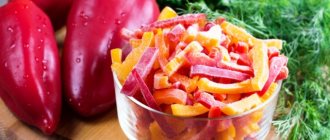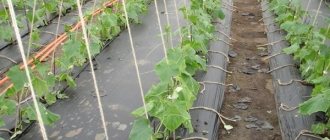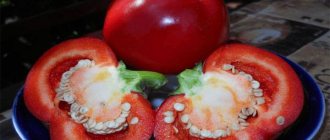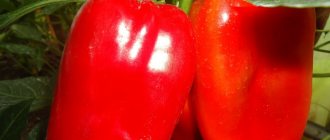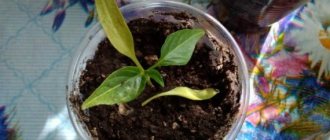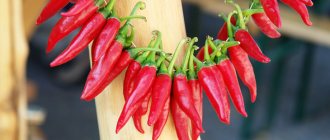Gardeners plant a wide variety of vegetable crops on their plots. Bell pepper is not rare among them. Summer residents pay great attention to the characteristics and descriptions of varieties, among which the hybrid vegetable crop “Prince Igor” occupies a special place.
Gardeners and breeders leave only the most flattering reviews about this variety. The photo allows you to understand how appetizing peppercorns can be. The yield of the plant is amazing in its size.
Pepper “Prince Igor” is attractive to many gardeners due to its external characteristics and description of the variety. Reviews about the yield of the variety can only be found positive. Looking at the photo of the fruits, I want to grow them throughout the Russian Federation.
Description of the variety
The hybrid is called “Prince Igor”, it is very popular. It is grown throughout Russia, excluding the regions of the Far North. At the agricultural exhibition in 2021, this particular variety was named the winner. The vegetable is capable of producing a good harvest when grown:
- under oilcloth material;
- in greenhouse conditions;
- on an open ridge.
The hybrid crop is grown on the territory of a personal plot and farms.
The hybrid “Prince Igor” is characterized by the following properties:
- From germination to ripening it can take from 108 to 113 days.
- The bushes are powerful and spreading, of medium height, covered with large, slightly wrinkled foliage, which has a rich green tint. Plants grown in open ground can reach a height of about 70 cm, but sometimes there are specimens whose growth exceeds the meter mark. In greenhouses, bushes can grow to a height of 120-130 cm.
- Plants are distinguished by their fertility. At the same time, from 16 to 20 peppercorns can ripen, and sometimes 25-27 excellent large fruits can grow.
- From each square meter of plot you can collect up to 10 kg of delicious peppers.
- Horizontally located fruits have a cylindrical or elongated cuboid shape. During the period of technical maturity, peppers are dark green. When the fruits ripen, they become dark red. This usually occurs after 140 days.
- The weight of the fruit ranges from 120 to 125 grams, but there may be specimens whose weight exceeds 150 grams.
- Bushes adapt to any weather conditions.
- Inside the fruit you can find juicy, crispy, very dense pulp, which contains a large amount of vitamins and minerals, especially group C.
Advice. In cold and rainy summers, the fruits may turn red for a long time. To speed up this process, it is recommended to get rid of the lower leaves and ovaries that clearly do not have time to become large fruits.
Main advantages of a hybrid
Among other features of the “Prince Igor” pepper, it is worth noting its high yield. On the bushes of this plant, from 15 to 25 large fruits are formed simultaneously.
Advice. Since the plant itself is tall, and an additional heavy load falls on it, it is recommended to tie it to trellises or other supports.
The productivity of the hybrid form is very high. In open beds, a vegetable crop from 1 hectare allows you to harvest at least 420-450 centners of ripe fruits. When grown in greenhouses and under other film covers, the variety produces 1 sq. m. about 22 kg of mature peppers.
From 1 sq.m. you can collect up to 22 kg of peppers
Among other advantages of this hybrid, gardeners note the plant’s resistance to various unfavorable external factors. The variety is not afraid of low light and low air temperatures.
Attention! The hybrid "Prince Igor" is resistant to verticillium, fusarium and tobacco mosaic virus.
How to properly grow pepper varieties “Prince Igor”
Seedlings are planted at the end of the winter period. First, the seeds are checked for their germination. Clean tap water is poured into a small container. Next, add one tablespoon of salt and mix the mixture thoroughly, then add the seeds.
If they do not sink to the bottom, then in this case they should be thrown away. According to experienced gardeners, such specimens completely lack the strength to grow, which leads to a lack of sprouts after planting in the ground.
Important! In warm water, the seeds will sink to the bottom, even if they do not germinate.
You need to decide in which container the plant will be planted. Too large pots will not work. Soil is poured inside the boxes. Usually you buy it in stores or make it yourself, mixing it in the optimal required proportion. Subsequently, the earth is placed in the oven, in which it is heated to a certain temperature.
While the earth is warming up, pour cold water into a glass, and then put the seeds. They can stay here for 3-4 hours. Next, you need to wrap the planting materials in a damp cloth and place them in a warm place for 3 days. At the end of this period, the seeds are checked for the presence of sprouts.
If the planting material is swollen, then it should be planted in prepared containers, watered well and covered with plastic wrap or glass. When small plants appear on the surface, the cover should be removed.
Important! Excellent plant growth is ensured when the temperature ranges from 25 to 27 degrees Celsius. At night the temperature should be between plus 10 and plus 15 degrees.
Excessive watering harms plants; they can develop such a dangerous disease as blackleg. Water the seedlings with warm water. If you water with cold water, the crop may soon become frail, be susceptible to various diseases, and even die. The bushes need to be sprayed and the room ventilated, but the pepper should be protected from draft winds.
In order for seedlings to grow faster, additional lighting should be used. Before planting in a permanent place, the seedlings should be hardened off, gradually accustomed to the sun's rays and the negative effects of low temperatures, winds and rains. First, the boxes with seedlings are taken out onto the balcony or veranda for a short period of time, gradually increasing the stay time.
Important! It is necessary to monitor the weather, as frosts or low temperatures can lead to the death of plants.
Description of the fruits of the pepper “Prince Igor”
Numerous gardeners are primarily attracted to this hybrid by the external characteristics of the fruit and their taste properties. The variety of peppers “Prince Igor” allows you to obtain vegetables with an elongated cuboid or cylindrical shape. Their surface is slightly ribbed. The fruits are very beautiful, glossy, appetizing. During the period of biological ripeness, they acquire a rich and dark red color. When ripe, the peppers of this vegetable crop have a deep green hue.
Other features of the fruits of this variety are their fleshiness and juiciness. This is not surprising, since the wall thickness of peppers varies from 7 to 10 mm.
Pepper “Prince Igor” is not bitter at all, so it is excellent for cooking
According to reviews from breeders and gardeners, the “Prince Igor” pepper is very tender and juicy. It contains a large amount of ascorbic acid. Thick-walled fruits are devoid of notes of bitterness. They are distinguished by a refined and piquant “pepper” aroma. The pulp of these vegetables is crispy, juicy, and dense. It contains a large amount of dry matter. Peppers have excellent presentation. Thanks to their fairly dense skin, they fit well and are easily transported, which makes this variety an excellent solution for cultivation for sale.
The excellent taste properties of vegetables with notes of pleasant sweetness have made this hybrid very popular. Peppers can be eaten fresh. The harvest goes well for:
- Extinguishing.
- Preparing first courses and salads.
- Canning.
These fruits are especially highly valued by chefs who cook lecho.
Pepper "Prince Igor" is unpretentious in cultivation
The hybrid form of the “Prince Igor” pepper variety is an excellent vegetable crop that can be grown in different conditions. It is very stable and produces an excellent harvest almost regardless of weather and other factors.
Planting peppers in a permanent place
After waiting for the crop to grow, it is necessary to transplant it to a site specially prepared for this.
You may be interested in: Favorable days for picking pepper in 2021 according to the lunar calendar Favorable days for planting pepper for seedlings in 2021: terms and rules for sowing at home Favorable days for sowing sweet and bitter pepper for seedlings in 2021
The variety “Prince Igor” takes root well on light and fertile lands. It is optimal to plant peppers after:
- cabbage;
- Luke;
- cucumbers;
- pumpkins.
Excellent productivity is provided to peppers by soils on which green manure plants previously grew. They can replace fertilizers.
Important. Potato, pepper or tomato beds are not suitable for planting “Prince Igor” pepper, since the plant often suffers from the same diseases that its predecessors suffered from.
If the garden plot is small and the choice of suitable land for planting peppers is difficult, you can dig up the same plot, adding a large amount of fertilizer during the work.
For planting, small grooves are made, into which the seedlings are planted after 40 cm. There is a 60-centimeter distance between the furrows. Soil is poured into small depressions, then the sprout is placed there, after straightening the root system. It is important to leave the root part on the surface. This measure will help avoid plant rotting. Then the hole is completely filled with the remaining soil.
Pepper is a very moisture-loving plant, so it should be watered thoroughly.
Important! In order not to damage the root system before planting, it is necessary to drive a peg near each hole, to which the young bush will subsequently be tied.
Experienced gardeners recommend fertilizing three times. For the first time, young seedlings are fed when 4-5 leaves appear on the stem. Fertilizers are applied for the second time 20 days after the first feeding. And the last time they feed is during the fruiting period, since it is necessary to support the plant during the difficult period of fruiting.
In dry weather conditions, plants should be watered every day. Be careful not to get water on the delicate leaves. During the summer, the ground around the pepper is loosened and weeded to remove weeds. This will ensure better growth and an excellent harvest.
Advice! To prevent the bushes from breaking, it is recommended to tie them to supports driven into the ground.
Peppercorns usually ripen by the end of July. But fruit ripening occurs before the air temperature drops below 10 degrees. As soon as the first frost hits, the plant dies.
Agricultural technology for growing bell peppers
Sowing of seedlings is carried out in early March, picking seedlings - in the phase of one true leaf. Seedlings are planted in a permanent place in the ground at the age of 70 days from germination.
Planting pattern : 50 x 35 cm.
To ensure the best yield, it is better to plant peppers in areas where legumes, cabbage or cucumbers grew last year.
Feeding sweet peppers
During the process of growth and fruiting of pepper, it is necessary to add additional fertilizers to the soil:
- 1st feeding a couple of weeks after planting. Use a superphosphate solution at the rate of 2 teaspoons per 10 liters of water. One bush requires about a liter of solution.
- The 2nd feeding is carried out during flowering. The previous composition of the solution can be supplemented with 1 teaspoon of potassium sulfate and 1 teaspoon of urea, and the dose of superphosphate can be doubled.
- The 3rd feeding occurs during the ripening period of the peppers. For 10 liters of water take 2 teaspoons of superphosphate and the same amount of potassium salt.
If you grew sweet pepper Prince Igor, please write whether you liked it or not. What was the yield and taste of the fruits like under your climatic conditions? If possible, attach a photo of this pepper to the comment. Thank you!
Your reviews of the Prince Igor pepper will help many gardeners evaluate this hybrid objectively and decide whether it is worth planting or not.
Measures to promote a good harvest
To get a good harvest, you must follow some rules:
- The roots are healthy and strong and cannot be damaged during transplantation. To reduce the risk of damage, when preparing the holes, you should drive a peg next to each one, on which the adult plant will then rest.
- Since there can be up to 10 peppercorns on the bush at the same time, it must be tied up.
- If the weather is unfavorable, the pepper is covered with plastic wrap. This measure will help prevent the death of the Yellow Bell variety.
Disease Control
Sometimes the plant can be susceptible to various diseases. To reduce your risk, you should follow these tips:
- To prevent black bacterial spots, seed disinfection using a potassium permanganate solution helps.
- To combat late blight disease, it is necessary to soak the seeds in potassium permanganate. The plant is re-treated in July. Onion peels help to cope well with the disease.
- To prevent “blackleg”, planting is carried out in good soil. In addition, water the plants with lukewarm water, avoiding draft winds and excessive moisture. If the soil on the site is susceptible to contamination, then 5-7 cm of soil is removed, then the greenhouse is disinfected. To do this, you can use a sulfur bomb or bleach in a one-to-one ratio. When planting young plants, weak and diseased specimens should be rejected. In addition, seedlings should not be allowed to become dense.
Pest and disease control
In addition, pest control is important. The most common of them are aphids, spider mites (they feed on plant juices) and slugs (they eat not only stems, but also fruits, which leads to their rotting). With excessive humidity and cold weather, the so-called black leg may appear - darkening of the skin of the stem at the base, which is fraught with rotting and further bending of the plant.
The main precautions against pests and diseases: compliance with agricultural cultivation techniques, keeping the beds clean, as well as the watering and loosening regime. If pests appear, promptly treat with the necessary insecticide. For example, keltan and krabofos help against aphids.
As for folk remedies, a solution of 1 cup of ash in 10 liters of hot water helps against aphids, which, after mixing, is left to infuse for a day. Immediately before treatment, add a tablespoon of liquid soap to the solution, after which the plants are sprayed. Spider mites are fought with 1 cup of ground onion with dandelion leaves per 10 liters of water. A tablespoon of liquid soap is also added to the solution. Slugs are repelled by pollination with mustard powder or ground black pepper at the rate of a teaspoon of powder per 1 square meter. m.
Important! Any chemical treatment of bushes should be carried out before and after flowering. During the period of fruit formation and growth, plants cannot be processed! Then it is better to turn to traditional methods.
Thus, the “Prince Igor” pepper variety is super productive, universal, suitable for growing both at home and on farms. The possibility of fairly long-term storage and transportation makes it a commercial variety. That is why it is in demand among manufacturers, while consumers appreciate its chic taste.
Reviews from gardeners
The delicate and original taste of the fruits of the “Prince Igor” variety does not leave anyone indifferent. This pepper has many positive characteristics. What amazes many in particular is that the variety is able to withstand the negative effects of various diseases, is unpretentious and has high yields.
Andrey Mikhailovich, 54 years old, Kursk region:
“For 5 years now I have been growing pepper varieties “Prince Igor”. I like that the bushes are very productive and require minimal maintenance. My family and I enjoyed the delicious fruits throughout almost the entire winter.”
Alexandra, 47 years old, Voronezh:
“In January, we accidentally came across pepper seeds with the name “Prince Igor”. Although the packaging says that plants can grow up to 60-70 cm, in my area the specimens were exceptionally tall, so I tied them up. Already in mid-July I was able to try the first peppers. And how fragrant the salad turned out when adding this variety. I advise everyone to grow “Prince Igor” pepper on their plots. “
Agricultural technology
We sow seedlings
Sowing begins at the end of February and beginning of March. If you have a greenhouse, you can sow seeds earlier, but the main thing is to provide them with additional light. The transfer will be carried out outside from mid-May, into the greenhouse at the beginning of the month. By this time, your seedlings should already be about 20-25 cm, quite strong. To do this you need to do everything right.
Hybrids, as a rule, do not need to be treated for diseases, but you can check the seeds for germination and soak them in a growth stimulator.
So, start by preparing the soil and cups. Yes, we always recommend taking cups or combining them with peat tablets. This is convenient, there is no need for picking after, planting in a container made of paper or peat can be done immediately in the ground. And the seedlings do not suffer, they adapt faster, because the roots of the seedlings are the most delicate place, and you save time and nerves. Let's look at the technology with tablets. The process will be as follows.
- Before planting, the tablets need to be soaked for 15-20 minutes to allow them to swell.
- The seeds are checked for germination a couple of days in advance - soaked in slightly brackish water. Empty seeds float, then before sowing they are placed in any stimulant for a day.
- When the tablets become “barrels,” place a seed in each cavity.
- Place the “barrels” in a tray and cover with film to create a greenhouse.
- The temperature should be above 26 degrees.
- When you see that the seeds have sprouted, you need to remove the film.
- Every day, open the cover slightly to allow air inside the tray.
- Those “barrels” that have not sprouted, put them back under the film - seedlings can sprout in different ways.
So, your “Prince Igor” pepper has grown, now it only needs watering and light. The first is done by pouring water into the tray. When the seedlings become larger, they are placed together with the “barrel” in a peat pot or cardboard cup and covered with soil. This could be a mixture of sod ash and soil from a nightshade store. It is important to spill boiling water with manganese on any soil - this will disinfect it. Your seedlings will not need anything else, just light and watering.
If you don’t have south and east windows in your house, and you are desperate to grow seedlings because they are stretched, then just buy lamps. Not everyone can afford special ones, but simple daylight ones also come to the rescue. They don't spend a lot of energy, but they can help. If you see that the seedlings have begun to stretch out greatly and, even worse, break at the base, then you urgently need lamps over the seedlings and nitrogen fertilizing to restore greenery.
Transfer to the street
The area is cleared of weeds in advance, humus, peat or sand are spread over it for drainage and a little ash. If the soil is acidic, then add lime. All this is being dug up together. You can pour fertilizer into each hole when planting so that the nutrient mixture fills it about halfway. You also need to pour boiling water over this area to drive out parasites and kill pathogenic flora.
It is especially important to prepare the site well if you are planting for the first time in this place and there is an abandoned vegetable garden nearby. In such places there are always a lot of parasites that can bother even those varieties and hybrids that are resistant. The reason is banal - there is no culture that can be eaten, insects attack what they find. It is important to always remember about predecessors that have similar pests and diseases. It is better to prevent all risks than to deal with the problem later. Peppers are not planted after tomatoes, potatoes and other nightshades, but after legumes, herbs, herbs, onions and garlic, please.
Seedlings need to be hardened off for 10-14 days - taken out onto the street or balcony, gradually increasing the time. The holes are shed with warm water and the seedlings are planted.
Then the area can be covered with mulch - this warms the roots, prevents them from overheating from the scorching sun, and stores moisture. And productive varieties require a lot of moisture.

